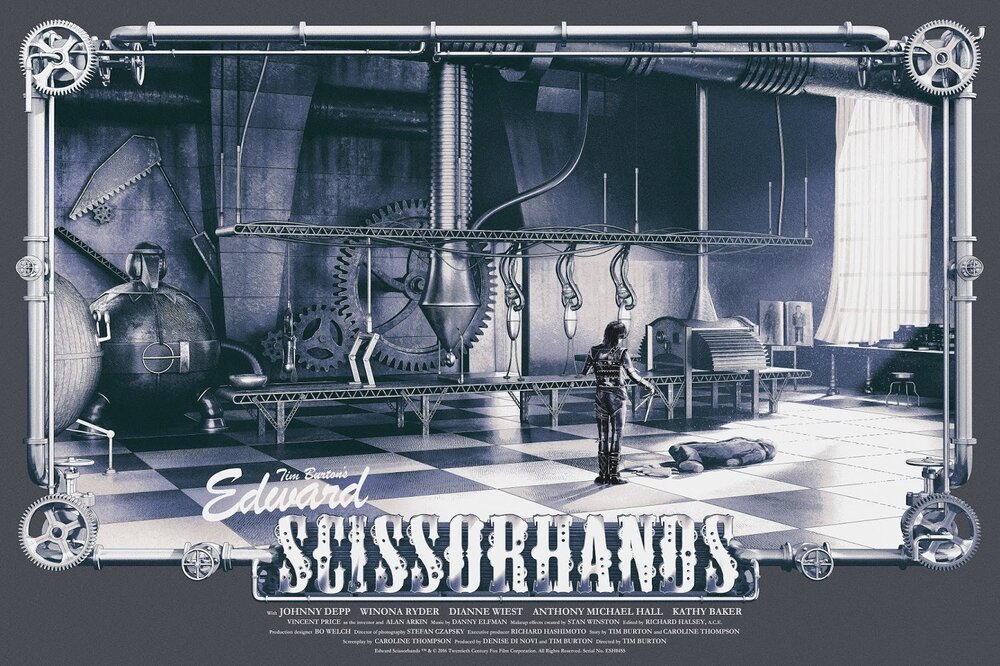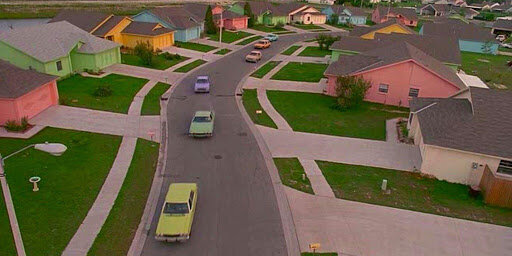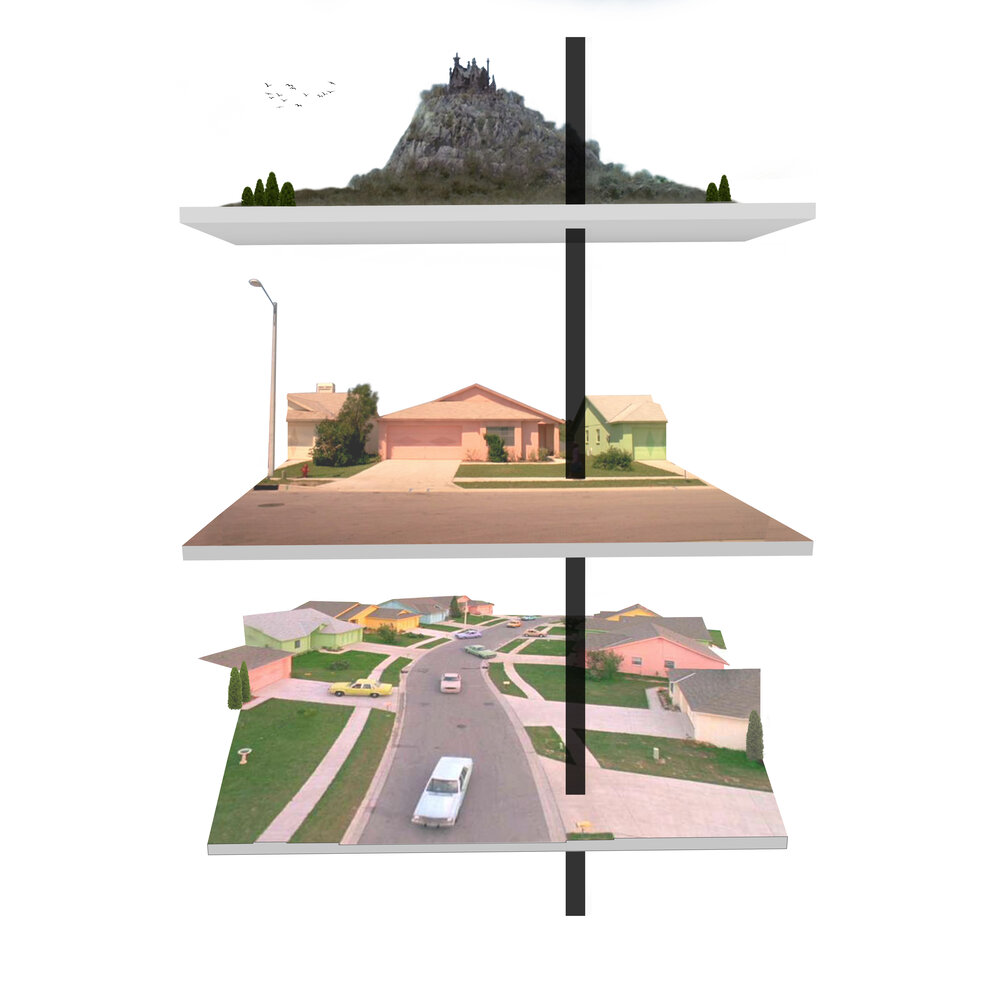
(Image: insidetherockposterframe.blogspot.com)
The Pursuit in Deconstructing the Dream
By Ezekiel Nelson
In a setting where the ideal suburban life has manifested into its full form, far separate from urban pressures, individual lifestyles and attitudes begin to morph into something distinctively different than that of city living. Settling into a home and life vacant of shops, plazas, markets, and all other services and opportunities the urban fabric has to offer rids one of everyday meaningful experiences. The small section of the suburban world one occupies condenses and poorly simplifies life through a narrow view frame. In such a sterile setting, common distractions are sanitized and eradicated, along with environmental sensory stimulation. This may be beneficial for short periods of time, but environmental stimulation is also necessary for human existence and sense of identity. Tim Burton’s film Edward Scissor Hands reveals the intricacies of such a vapid world (1). Through the use of setting and timeframe, characters are shown operating on a much-anticipated daily schedule, with perfectly manicured matching lawns, colorful pastel yet identical homes, and the same cars filling every driveway. The city itself is absent from the film, yet every morning when all the men walk out of their identical homes to their identical cars at the exact same time and drive out of frame, the city is referenced. Writers have often explored the reasoning behind the great escape from the city to the postmodern neighborhood in the last century. But was it really an escape, or actually a desire to falsely shine as an individual?
Detached from Distraction
Distraction and the positives of engaging with the urban environment play into one another and provide an example of what is lacking in Edward Scissorhands (2). Noting ques from Stan Allen’s “Dazed and Confused” on the topic of distraction, there are both positive and negative outlooks (3). However, in relation to a suburban lifestyle, the positive view on distraction and its necessity holds more ground. In the movie, drama is more easily created and social cliques thrive. Small events that would go perhaps somewhat unnoticed in a city now have too large of ripples that grab everyone’s deprived attention. Everyday distractions urban life has to offer places ones focus on what’s important, and true distraction becomes increasingly harder to encounter. In relation to George Simmel’s “The Metropolis and Mental Life”, a closed and constant circle of individuals prevents true individual thinking as each individual becomes accustom to one another, subconsciously formulating decisions and views in reaction to the others within the group (4). In an urban setting, the inevitable constant contact with different populations creates the sense of a free soul and promotes individual thinking. In short it may be easier to be a true individual in a context of many than that of few.

(5)
Unsetting Setting
In experiencing the postmodern neighborhood on the street, sidewalk, or even lawn, the setting may seem acceptable. This viewpoint, being it’s our everyday visual experience, confines us to a singular method of spatial experience. This repeated singular method of experience often prevents the curiosity to analyze the behaviors and settings around us. In short, we are so accustomed to the lifestyles we are immersed in, that the peculiarities elude us. Burton recognizes this flaw and capitalizes on it by providing new viewpoints into the operations of the suburban lifestyle. We start by seeing shots of the neighborhood where the camera is far removed from the street, houses, and people. From here the numbing repetition of houses, hedges, and even behaviors are visible. An aerial view allows viewers to witness the men exiting the house in the morning and parading down the street in their colorful versions of the same car at the exact same time and later returning in the same manner.
In Jacques Tati’s Playtime, the set is entirely made to grant Tati the complete control to put his character’s errors on display (6). In Edward Scissorhands, the removed shots of the neighborhood and its manicured state insinuate the use of a set as well, however, an existing neighborhood is used. Burton used this neighborhood and its similarity to a set to drive home the message of how conformed and predictable the block really is. The houses, cars, lawns, and even sky look like painted props, too idealized to be true.
The constructed representation of architecture achieving similar set-like deceit is put behind the lens in the movie The Truman Show. This existing town by the name of Seaside exists in Florida as part of a New Urbanist movement. In Douglas Cunningham’s “Theme Park Built for One: The New Urbanism vs. Disney Design in The Truman Show (7)", the process for finding the town used the adjective “idealized” to describe what the film crew desired to find. The use of the word “idealized” stands important for it drives the point home how the films setting takes on the role of a commonly imagined neighborhood/town.
Not quite New Urbanism, but the postmodern neighborhood in Edward Scissorhands is able to achieve a similar level of distraction (8). In the film, each house resembles our collective understanding of what a house is. Occupants accept and recognize these houses, these lawns, these streets, but they never seem them from the distant and elevated perspective the director grants us. They are distracted by these representations that it becomes difficult for them to see the suffocating nature of their lifestyle. Burton unsets the viewer from the setting to reveal and understand its exaggerated oddities.
Dream of Uniqueness
The discussion circling the postmodern neighborhood thus far describes as a somewhat obvious display and execution of conformity, but why is this not actually the case? Why do those in this Burton neighborhood not see it like we do as viewers to the film. The filming strategies already discussed were used in displaying conformity, but the false projection of individuality that infects postmodern suburbia or desire to move there remains the true culprit to hidden conformity. To progress this point and line of thinking, the composition of the “individual” mentioned earlier must be brought back and expanded upon.
The initial mentioning of the “individual” was tied to distraction—and the lack of it—found in the suburban environment, but this remains only a part on how the setting effects individuality. Originally, the argument was placing individuality against collectivism, but in this neighborhood, it is no longer that simple. Individuality is a stop on the path to something more desirable: uniqueness. The word individual is confounded to belonging within specific set or perhaps even group. One can remove an individual jellybean from the bag of jellybeans. One cannot, however, remove something unique from the same bag of jellybeans unless it is fundamentally different, like say, a black bean. Unique stands free from any confines and that is what in terms makes it indeed unique. As an individual in the suburban neighborhood, I have my own house, my own lawn, my own driveway and even my own hedges. In an urban setting, this may have made one unique, but in an area that was specifically developed to allow all those who moved there to own the same thing, uniqueness fades. Further, the social pressures on the maintenance and aesthetic of these individual properties in turn completely removes uniqueness from the scene altogether. Timothy Morton’s, “Architecture Without Nature” writes this point, “…think of the generic American front lawn: they are individual insofar as they embody the private property of an individual. But they are far from unique. In fact, in many jurisdictions attempts to make the front lawn unique are banned. The lawn must conform to a certain standard…” (9). The aesthetic of the cut green lawn seen heavily repeated do not just visually show a lack of uniqueness, but the pressures to now blend with your surroundings accelerate conformity. Burton took every piece of individuality seen in the neighborhood, exaggerated it, then copied and pasted it over a dozen times resulting in the physical argument of false uniqueness and hidden conformity.
Rejection of the Dream

Edward, based on his initial behavior around others, never encountered an opportunity to engage with the world around him. In short, Edward never had the opportunity to understand himself in relation to the context around him. This new suburban setting allows him to do that, but immediately he meets the cage of conformity. A scene that shows this right away is the first of many where Peg is attempting to cover Edward’s scars. It might be even said that the motivation to bring Edward into the neighborhood came from intentions to conform him. Conformity remains Edwards biggest obstacle throughout the movie, and Tim Burton’s exaggerated setting shows a world shaped by this conformity. At first this world gives Edward the illusion of creativity and individual opportunity, but slowly his personality and creativity add to the conformity of the town. A hedge is cut into an elaborate shape, now everyone must have the same.
Edward and his uniqueness as an intrusion through the postmodern neighborhood.
Edward has human qualities but is indeed inhuman. Visually, and at a level physically, those who encounter him relate to him, but are also easily reminded of their differences. The character was quite literally brought down from a fantasy world above to the suburbia below. A character displaying fantasy and fairy-tale in almost all aspects of his form removed from his corresponding fairy-tale dwelling to a simplified and colorful reality. The memories Edward has, flashing back to his mansion with his inventor, the interior spaces are dark, gloomy, melancholy, and display that Burton interpretation of German Expressionism. Edward blends into this setting without question or pause. Even his construction and physical form don’t draw too much attention, for it is somewhat camouflaged by the shiny, dark, and busy environment he is built within. In his new setting however, we see Edward’s character challenge the people of suburbia, show creativity, honesty, and love. The suburbia struggles in taking to Edward’s character, uniqueness, and displays of creativity by attempting to normalize his gift into mundane practices. What would have been a feat and extreme wonder in humankind is instead transformed into a lawn worker and haircutter.
Once the inhuman characteristics of Edward began to show in his inability to normalize, that is when the community’s opinion on him changes to a negative one. Perhaps the people of the neighborhood suddenly see the reality of their personalities, flaws, and lifestyles reflected at them in Edwards failure to match them. An internal jealousy flares at the subconscious reminder of their failure in reaching uniqueness as Edward unapologetically succeeds at it.
The chase after individuality while falsely considering it unique produces an outcome that limits one’s potential. It becomes a beaten path to a hidden conformity and destruction of uniqueness. Distraction diminishes leaving deprived minds, and styles and behaviors level to a conformed baseline. Once the a truly unique character is brought into the scenario, it’s rejected out of subconscious jealousy or conformed before the uniqueness of this individual can establish any impact. In pursuing an un-unique dream to individuality, the pursuit leads way to the destruction and rejection of the goal.
BIBLIOGRAPHY AND WORKS CITED
1- Edward Scissorhands. 20th Century Fox, 1990.
2- Edward Scissorhands. 1990
3- Allen, Stan. “Dazed and Confused.” Assemblage, no. 27 (August 1995): 47.
4- Simmel, Georg. “The Metropolis and Mental Life.” Metropolis, 1995, 30–45.
5- Guerrasio, Jason. “'Edward Scissorhands' Is Turning 25 - This Story from the Film's Production Designer Proves Tim Burton Is a Creative Genius.” Business Insider. Insider Inc., October 12, 2015.
6- Playtime. Specta Films, 1973
7- The Truman Show, 1998. The town and suburbs impersonate our common idea of a neighborhood and attempts to centralize all aspects of urban living within a town. Like theatre, this neighborhood is then literally occupied with hundreds of actors distracting Truman and views from the strange reality he occupies.
8- Edward Scissorhands. 20th Century Fox, 1990.
9- Morton, Timothy (2012). Architecture Without Nature. _Tarp_ (10):20-25.

LOGO DESIGNED BY MEENTS ILLUSTRATED
from REVIEW BLOG - Every Movie Has a Lesson https://ift.tt/2PkYZlQ







Welcome to We Buy Houses Colorado Springs, the Official Cash Home Buyer of Colorado Springs, Colorado, and surrounding areas.
ReplyDeleteWe provide home sellers with a cash option to purchase their property quickly—with NO Repairs, and NO Fees or Commissions.
Simply go to our website or call us at (719) 300-6335 to get a no-obligation cash home offer sent to you. It’s free and confidential.
foreclosure? Facing divorce? Moving? Upside down in your mortgage? Liens? It doesn’t matter whether you live in it, you’re renting it out, it’s vacant, or not even habitable. We help owners who have inherited an unwanted property, own a vacant house, are behind on payments, owe liens, downsized, and can’t sell… even if the house needs repairs that you can’t pay for… and yes, even if the house is fire damaged or has bad rental tenants.
Basically, if you have a property and need to sell it… we’d like to make you a fair cash offer and close on it when you’re ready to sell.
Just contact us today to get started!
Most Trustworthy Platform To buy instagram followers , buy instagram likes and buy instagram views instantly and Grow your Engagement ❤ Best Customer Support 24/7 and Instant Delivery.
ReplyDelete